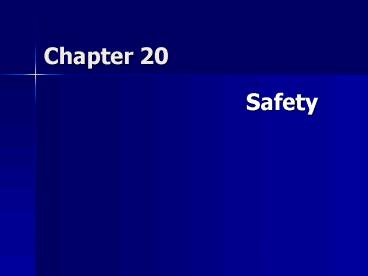Safety - PowerPoint PPT Presentation
1 / 22
Title:
Safety
Description:
Warning approach: Put up signs. Guarding approach: Install a guard. ... An effective warning should change behavior. May be visual, auditory, or vibratory. ... – PowerPoint PPT presentation
Number of Views:57
Avg rating:3.0/5.0
Title: Safety
1
Chapter 20
- Safety
2
Goals of Safety
- Reduce errors
- Reduce proportion of errors that become accidents
- Reduce proportion of accidents that become
injuries - Reduce lost days/injury
3
Injury and Severity Rate
- Injury rate Injury cases/year
- 200,000
- Actual hours worked/year
- Severity rate Days charged
- Injury cases/year
4
Selection of Problems
- Decision method
- Multiply frequency rate for each type of accident
by the severity rate. - Consider refining by including dollar cost/case.
- Rank order annual costs.
- Consider using a Pareto analysis.
- Examine high-energy sources.
5
Management Approach
- Management commitment to safety is the dominant
factor in success. - Consider joint management/worker committees.
- Categorize accidents
- Unsafe conditions
- Unsafe acts
- Charge Worker Compensation and medical costs to
the department.
6
Open Manhole Analogy
- Warning approach Put up signs.
- Guarding approach Install a guard.
- Engineering approach Cover the hole.
- The engineering approach is most effective and is
permanent.
7
Reduction of Unsafe Conditions
- Reduce equipment failure
- Design the proper control, display, and
environment - Use distance
- Use guards
- Use time
8
Reduce Equipment Failure
- Reduce the Failure Rate
- Reduce the number of failure locations.
- Design in safety factors.
- Use redundant equipment (parallel or standby).
- Use preventive maintenance.
9
Reduce Equipment Failure (cont.)
- Reduce Hazard
- Use GFCIs to eliminate electrical hazard.
- Use fail-safe designs (fuses, deadman throttles).
- Use battery power or compressed air instead of
110V. - Use smaller amounts of dangerous materials.
- Use radial tires and front-wheel drive.
10
Use Distance as a Protective Technique
- Separate people from equipment.
- Reduce speeds.
- Provide vertical clearance for people and
vehicles. - Provide barriers and walls (guards).
11
Use Guards as a Protective Technique
- Use guards that cannot be defeated easily.
- Make guard defeat or failure easily detectable.
- Guards should not present a hazard.
- A poor guard is a hazard.
12
Machine Guards
- Are attached to equipment to prevent people from
dangerous contact. - Do not accept guarded by location.
- Consider guards as part of a layered defense.
- Use lockout/tagout procedures.
- Purchase guards from the manufacturer when the
machine is purchased. - Guards should not impair machine function.
13
People Guards
- Are protective clothing.
- Problems
- Failure of protective clothing results in injury.
- Workers have incentives not to use protective
clothing. - Have a variety of sizes available.
- Impose severe penalties for not using safety
equipment. - Organizations should purchase and maintain the
equipment.
14
Fault Trees
- Use symbols to show how an accident could occur.
- Consider using mathematics to quantify
probabilities. - AND gates attenuate probabilities.
- OR gates multiply probabilities.
- Look for single-point failures.
15
Unsafe Acts
- Treat all accidents as unsafe conditions.
- Unsafe acts may result from
- Lack of knowledge
- Deliberate risk
- Drug effects
16
Lack of Knowledge
- Make a fault analysis of all possible failures.
- Consider both operator errors and equipment
failure. - Provide a decision structure table in case of a
problem. - Communicate this information to people at risk.
- Remember that training is not permanent.
17
Deliberate Risk
- Occurs because risk is low, cost of compliance is
high, or rewards are large and immediate. - People modify their behavior to take more risks
when a device reduces the risk. - Reinforce safe behavior with positive rewards
punish unsafe behavior. - Consider using a safety traffic light.
18
Drug Effects
- Alcohol contributes to a significant number of
accidents. - Focus on changing the machine/system rather than
the individual.
19
Warnings
- Are information about a possible negative
consequence. - An effective warning should change behavior.
- May be visual, auditory, or vibratory.
- Need increases when
- Injury potential increases
- Danger is less obvious
- Injury onset is not obvious
- More people are exposed
20
Problems with Warnings
- P The information must be Present.
- R The warning must be Read.
- U The reader must Understand the warning.
- M The person must Remember the information.
- A The person must Act on the information.
- E The warning must be Effective (the person
- must be able to perform the desired
- behavior).
21
Medical Management
- Emergency care
- Plant nurse
- First aid training
- Other provisions
- Rehabilitation and return to work
22
Use Time as a Protective Technique
- Limit exposure time to hazardous conditions or
materials. - Use GFCIs.
- Provide washing facilities for chemicals.
- Minimize distances to carry hazardous items.































